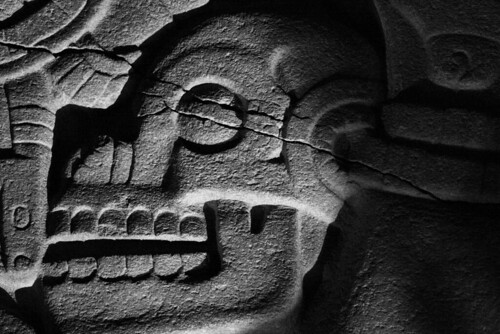Cinturon con calavera, de la Coyolxauhqui, diosa de la luna.
{eo} luna diino
{en} moon goddess
In Aztec mythology, Coyolxauhqui (Classical Nahuatl: Coyolxāuhqui IPA: [ko.jol.'ʃaːw.ki] which translates as "Face painted with Bells”) was a daughter of Coatlicue and the leader of the Centzon Huitznahuas, the star gods. Coyolxauhqui was a powerful magician and led her siblings in an attack on their mother, Coatlicue, because Coatlicue had become pregnant.
The pregnancy of Coatlicue, the maternal Earth deity, made her other children embarrassed, including her oldest daughter, Coyolxauhqui. As she swept the temple, a few hummingbird feathers fell into her bosom. Coatlicue’s fetus, Huitzilopochtli, sprang from her womb in full war armor and killed Coyolxauhqui, along with her 400 brothers and sisters. He cut off her limbs, then tossed her head into the sky where it became the moon, so that his mother would be comforted in seeing her daughter in the sky every night.

A large shield-shaped stone relief reflecting this story was found at the base of the stairs of the Templo Mayor. On this disk, Coyolxauhqui is shown spread out on her side, with her head, arms and legs chopped away from her body. The orbiting full moon in the stone carving reflects her position as the moon goddess. She is distinguished by balls of eagle down in her hair, a bell symbol on her cheek, and an ear tab showing the Mexica year sign. As with images of her mother, she is shown with a skull tied to her belt. Scholars also believe that the decapitation and destruction of Coyolxauhqui is reflected in the pattern of warrior ritual sacrifice. First, captives’ hearts were cut out. Then they were decapitated and had their limbs chopped off. Finally, their bodies were cast from the temple to lie, perhaps, on the great Coyolxauhqui stone.
She is a major deity in Mesoamerica, living on in other areas in the approach to worship in all-night prayer vigils ongoing today in central Mexico, fully clothed in Christian adoration mixed with local ancestral remembrances and invocations.
Coyolxauhqui’s celestial associations are not limited to the moon. Other scholars believe that she should be understood as the Goddess of the Milky Way, or be associated with patterns of stars associated with Huitzilopochtli.














No hay comentarios:
Publicar un comentario